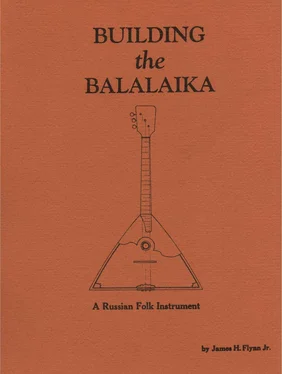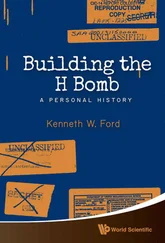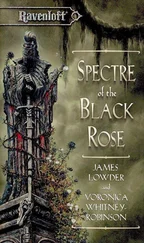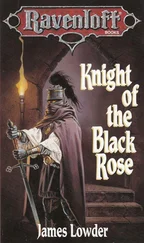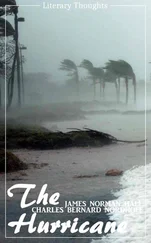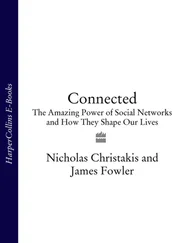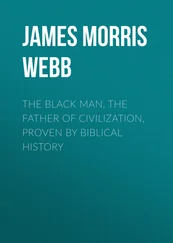James Flinn - Building the Balalaika
Здесь есть возможность читать онлайн «James Flinn - Building the Balalaika» весь текст электронной книги совершенно бесплатно (целиком полную версию без сокращений). В некоторых случаях можно слушать аудио, скачать через торрент в формате fb2 и присутствует краткое содержание. Год выпуска: 1984, ISBN: 1984, Жанр: Руководства, music, на английском языке. Описание произведения, (предисловие) а так же отзывы посетителей доступны на портале библиотеки ЛибКат.
- Название:Building the Balalaika
- Автор:
- Жанр:
- Год:1984
- ISBN:0-9613258-0-1
- Рейтинг книги:4 / 5. Голосов: 1
-
Избранное:Добавить в избранное
- Отзывы:
-
Ваша оценка:
- 80
- 1
- 2
- 3
- 4
- 5
Building the Balalaika: краткое содержание, описание и аннотация
Предлагаем к чтению аннотацию, описание, краткое содержание или предисловие (зависит от того, что написал сам автор книги «Building the Balalaika»). Если вы не нашли необходимую информацию о книге — напишите в комментариях, мы постараемся отыскать её.
Building the Balalaika — читать онлайн бесплатно полную книгу (весь текст) целиком
Ниже представлен текст книги, разбитый по страницам. Система сохранения места последней прочитанной страницы, позволяет с удобством читать онлайн бесплатно книгу «Building the Balalaika», без необходимости каждый раз заново искать на чём Вы остановились. Поставьте закладку, и сможете в любой момент перейти на страницу, на которой закончили чтение.
Интервал:
Закладка:
* PUBLISHER *
J. H. FLYNN, Jr.
1704 Drewlaine Drive
Vienna, Virginia, U.S.A. 22180
Copyright @by James H. Flynn Jr.
All rights reserved. No part of this hook may be reproduced in any form without the approval in writing from the author.
First Edition February 1984
Library of Congress Catalog Card Number 84-90311
Printed in the United States of America
All rights reserved by Author.
By Special Arrangement with the author, this PDF version was made available on a limited basis to BDAA members and to PennBO Alumni.
October 2004: With the permission of the author, this PDF version is available as a free download on the website of the Guild of American Luthiers: www.luth.org
PDF scanned by Riccardo Heald.

Acknowlegements
To my wife Mary... Thanks for everything.
It was fun loading the VW bus with Engelmann spruce in Santa Fe and the pungent Port Orford cedar in Oregon.... just to make more musical instruments! To our son Handy who did Russian translations for me when he was tired and weary... spasibo! And we cannot forget Balalaika and Domra Association's Hall of Famer Gregory "Grisha" Titoff for evaluating some of my early instruments and giving me useful comments for perfecting them. We enjoyed the many hours spent with him.
Introduction
Sitting here on the campus of the University of California at Berkeley in the summer of 1983 I am many leagues away from the Soviet Union, the native land of the balalaika. Nevertheless, beneath the tall pines and palms I can hear the ringing sounds of balalaikas and domras as members of the Balalaika and Domra Association of America (BDAA) strum their instruments in practice sessions at their fifth annual convention. The BDAA is a multi-ethnic association organized to perpetuate music written for the balalaika and domra and related instruments; to disseminate information pertaining to the musical and cultural heritage of Eastern European traditions; and to provide a forum for the exchange of ideas and developments concerning these instruments and their musical possibilities.
After much exposure to the balalaika and its music and chatting with some of the most talented players in the West, I feel that I should record some of the color and texture of these contacts. My objective, as an amateur luthier, is one of searching for and recording data pertinent to the building of the balalaika. I shall await another time to look at the domra. I was hopeful of obtaining a profile of what a true balalaika should look like as well as recording some of the personal preferences musicians may have in its design. With so many instruments available to me, as well as the opportunity to discuss their features with their proud owners, I believe that I was able to meet my goals.
Most players could recognize a "master" instrument... almost all knew what it took to make an instrument of high quality. I found instruments of superb craftmanship made by both Soviet and American luthiers. I was most pleasantly surprised to find that there are many balalaika makers in the United States and Canada. An even greater discovery was to find so many folks wanting to make their own instruments but lacking data from which to do so.
My hopes in preparing this publication are that it will provide those interested in the balalaika with some of the fundamental construction techniques as well as a description of the balalaika family with related dimensions. Above all, I would like to record this data in hopes of preserving the design of the instruments as the early Russian makers intended.
While I have no talent as a musician, I do have a keen attraction to the entrancing tonal quality of the balalaika. Working with wood and collecting a large variety of it has been a life-long hobby of mine, but my interest in musical instruments started after I retired from my profession as an operations research analyst. Living in Virginia, the Appalachian Mountain dulcimer was the natural instrument to gravitate toward. This truly American folk instrument still keeps my interests high but what more appropriate instrument to study next.... the balalaika, the official folk instrument of the Soviet Union. Why?

The Balalaika
There are many contemporary descriptions of the balalaika. I thought that it would be fitting to search out the official Soviet definition. The description is as follows: [1] Vertov, K.A. Atlas of Musical Instruments of the Nationalities of the Soviet Union. Moscow. 1963.
"The balalaika: A two or three-stringed instrument with a triangular or oval shaped body, a relatively long neck with a head tilted back slightly. The overall length of the instrument is 600-700mm. The body of oval-shaped balalaikas is chiselled out; that of triangular ones is made of individual wooden slats. The top is flat, with resonator boles cut into it, often in a star-shaped pattern. There are five fret marks on the neck. The strings are gut; one end is held behind (on top of) the body with a peg; the other connected to a wooden key in the head. The basic tuning is a "forth" (if there are three strings, the second and third are tuned in unison).
There is also a "forth-fifth" tuning, called "discordant", and the "guitar" tuning using a major and minor "third".
Sound is produced by strumming all strings with the fingertips of the right hand, as well as plucking individual strings. The balalaika is a comparatively young instrument. The first mention of it in written sources goes back to 1715 (i. I. Golikov, "Supplements to the Works of Peter the Great," 1792, p. 242). It is possible that the instrument arose as a derivation or deviation from the domra, and, having gained a wide distribution, it quickly supplanted a number of other instruments, including the domra.
Numerous cheap prints and folk illustrations attest to the popularity of the balalaika in country and city musical life. The application of the balalaika in the musical life of the people was diverse: song and dances were performed on it; it accompanied solo and ensemble singing; it was introduced into composition of various instrumental groups. In the 1880*s with the leadership of V. V. Andreyev, the folk balalaika was perfected; on its foundation were created a number of orchestral instruments with chromatic scales - piccolo, soprano (later disused), prima, secunda, alto, bass, and contrabass.
The first performance of a "balalaika club" took place in Petersburg (Leningrad) in 1888, after which balalaika (and after 1896 balalaika-domra) orchestras began to form with surprising speed all over Russia. The success of the balalaika in large part lay in its low cost and ease with which it could be mastered.
Orchestras of Russian folk musical instruments have become particularly widespread during the Soviet period. Folk songs and dances, compositions of classical composers, both foreign and Soviet, all fall within their repertoire".
The tuning data on the balalaika is depicted in Fig. 1 and is related to the lower portion of the piano keyboard. Fig. 1 also scales out the five instruments and compares their size with a six-foot measure. The parts of the balalaika are identified in Fig. 2.
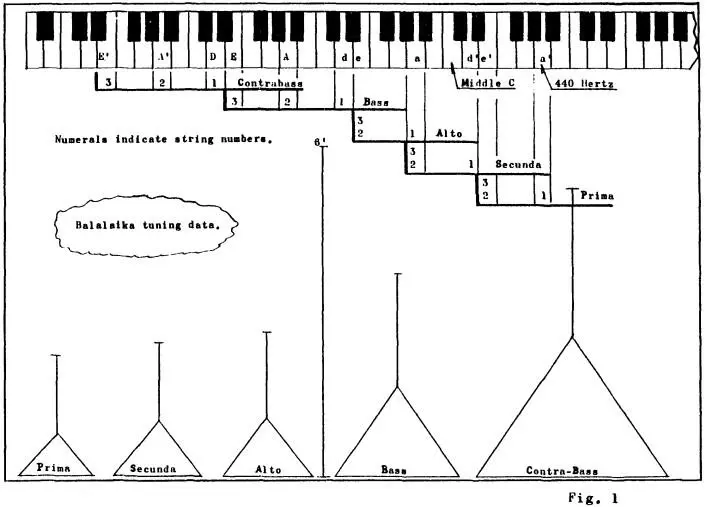
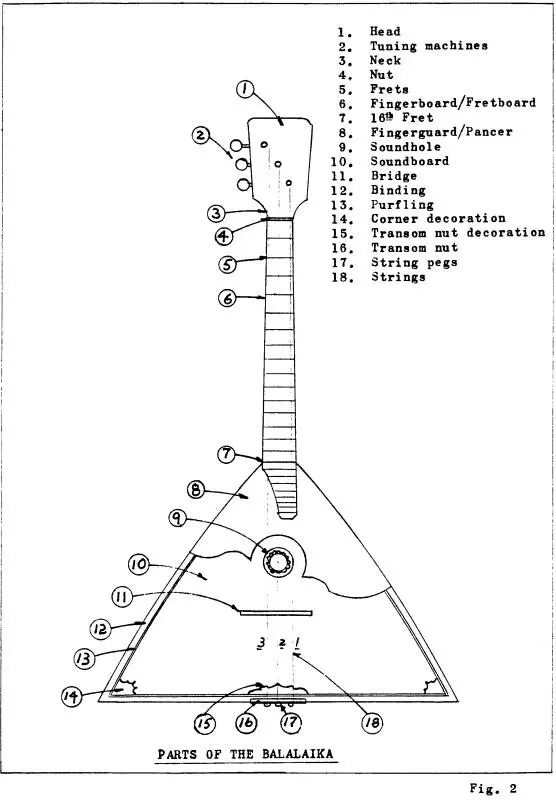 Читать дальше
Читать дальше
Интервал:
Закладка:
Похожие книги на «Building the Balalaika»
Представляем Вашему вниманию похожие книги на «Building the Balalaika» списком для выбора. Мы отобрали схожую по названию и смыслу литературу в надежде предоставить читателям больше вариантов отыскать новые, интересные, ещё непрочитанные произведения.
Обсуждение, отзывы о книге «Building the Balalaika» и просто собственные мнения читателей. Оставьте ваши комментарии, напишите, что Вы думаете о произведении, его смысле или главных героях. Укажите что конкретно понравилось, а что нет, и почему Вы так считаете.
